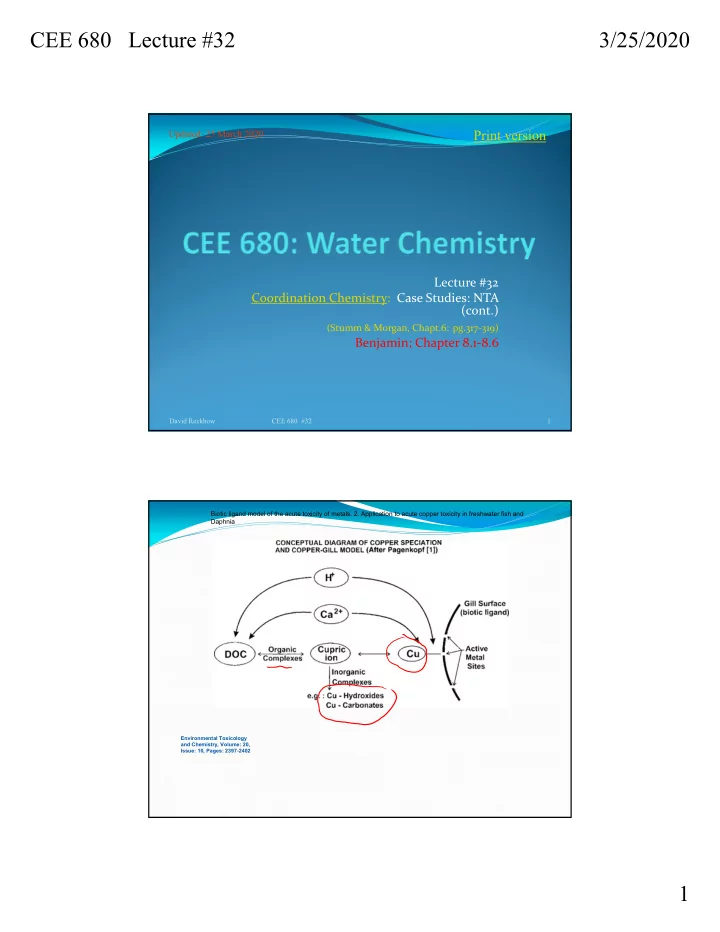

CEE 680 Lecture #32 3/25/2020 Print version Updated: 25 March 2020 Lecture #32 Coordination Chemistry: Case Studies: NTA (cont.) (Stumm & Morgan, Chapt.6: pg.317 ‐ 319) Benjamin; Chapter 8.1 ‐ 8.6 David Reckhow CEE 680 #32 1 Biotic ligand model of the acute toxicity of metals. 2. Application to acute copper toxicity in freshwater fish and Daphnia Environmental Toxicology and Chemistry, Volume: 20, Issue: 10, Pages: 2397-2402 1
CEE 680 Lecture #32 3/25/2020 Algae and Copper Fresh and salt water algae Depends on Cu +2 ion: 10 ‐ 7 M seems to work for most 𝜈 % 𝜈 ��� McKnight et al., 1983; Environmental Management 7(4)311-320 Add CuSO 4 Smith et al., 2015, Applied Geochemistry 57:55 2
CEE 680 Lecture #32 3/25/2020 Modeling the Fate of Metal Concentrates in Surface Water Environmental Toxicology and Chemistry, Volume: 38, Issue: 6, Pages: 1256- 1272, First published: 23 March 2019, DOI: (10.1002/etc.4417) Copper – NTA problem See: Knud-Hansen Paper NTA: nitrilotriacetate Used as a substitute “builder” in place of phosphate CH 2 COOH Good example of moderately N CH 2 COOH strong ligand Research interests: 70’s & 80’s CH 2 COOH General Review Perry et al., 1984 [Wat. Res., 18(3)255] Other Aspects Photochemistry: e.g., Langford et al., 1973 [ES&T 7(9)820] Biodegradation: e.g., Kuhn et al., 1987 [Wat. Res. 21(10)1237], Vanbriesen et al., 2000 [ES&T 34(16)3346] Bioavailability of bound metals: e.g., Bressan & Brunetti, 1988 [Wat. Res. 22(5)553] David Reckhow CEE 680 #32 6 3
CEE 680 Lecture #32 3/25/2020 Cu ‐ NTA II Thermodynamics (20ºC) Acid/Base H 3 NTA = H + + H 2 NTA ‐ pK 1 = 1.6 H 2 NTA ‐ = H + + HNTA ‐ 2 pK 2 = 3.0 HNTA ‐ 2 = H + + NTA ‐ 3 pK 3 = 10.3 Cu complex Cu +2 + NTA ‐ 3 = CuNTA ‐ p 1 = ‐ 13.0 Others are rather weak CuHNTA David Reckhow CEE 680 #32 7 From: Snoeyink & Jenkins, 1980 David Reckhow CEE 680 #32 8 4
CEE 680 Lecture #32 3/25/2020 Cu ‐ NTA III Specific problem Cu T = 10 ‐ 4 M 6.35 mg/L NTA T = 10 ‐ 4 M 19.1 mg/L Notes: this is a much higher concentration of NTA than is generally found, but it can be used to represent background natural organic matter Copper concentrations may sometimes be this high when used as an algicide We are ignoring other complexes such as copper hydroxides or carbonates David Reckhow CEE 680 #32 9 Cu ‐ NTA IV Mass Balance Equations Cu T = [Cu +2 ] + [ CuNTA ‐ ] NTA T = [CuNTA ‐ ] + [H 3 NTA] + [H 2 NTA ‐ ] + [HNTA ‐ 2 ] + [NTA ‐ 3 ] Definition: total free concentration (TF) is that which is unbound to any metal except H + NTA T = [CuNTA ‐ ] +NTA TF David Reckhow CEE 680 #32 10 5
CEE 680 Lecture #32 3/25/2020 Cu ‐ NTA V Equilibria 3 [ NTA ] Acid/base 3 NTA TF 1 2 3 [ H ] [ H ] [ H ] Complexation 1 K K K K K K 3 2 3 1 2 3 [ CuNTA ] 1 2 3 [ Cu ][ NTA ] David Reckhow CEE 680 #32 11 Cu ‐ NTA VI Substitute mass balance and alpha equations into the beta equation 2 [ CuNTA ] Cu [ Cu ] T 1 2 3 2 [ Cu ][ NTA ] [ Cu ] NTA 3 TF 2 Cu [ Cu ] T 2 [ Cu ] NTA [ CuNTA ] 3 T 2 Cu [ Cu ] T 2 2 [ Cu ] NTA ( Cu [ Cu ]) 3 T T David Reckhow CEE 680 #32 12 6
CEE 680 Lecture #32 3/25/2020 Cu ‐ NTA VII Now solve, noting that Cu T = NTA T 2 Cu [ Cu ] T 1 2 2 [ Cu ] NTA ( Cu [ Cu ]) 3 T T 2 Cu [ Cu ] T 2 2 [ Cu ] [ Cu ] 3 Which gives us a quadratic which can be solved for a given pH 2 2 2 [ Cu ] [ Cu ] Cu 0 3 1 T David Reckhow CEE 680 #32 13 Cu ‐ NTA VIII Then determine other species from the free copper [ CuNTA ] Cu [ Cu 2 ] T NTA NTA [ CuNTA ] TF T 3 ] [ NTA NTA 3 TF Can use a spreadsheet to calculate 3 versus pH, and then calculate the other species David Reckhow CEE 680 #32 14 7
CEE 680 Lecture #32 3/25/2020 1e-3 CuNTA - 1e-4 1e-5 Cu ‐ NTA IX 1e-6 Cu +2 1e-7 Figure shows 1e-8 Concentration (moles/L) impact of 1e-9 ligand 1e-10 NTA -3 speciation on 1e-11 extent of 1e-12 complexation 1e-13 1e-14 Same thing 1e-15 happens with 1e-16 fulvic acid 1e-17 1e-18 1e-19 0 1 2 3 4 5 6 7 8 9 10 11 12 13 14 David Reckhow CEE 680 #32 15 pH -3 CuNTA - -4 -5 CuNTA X -6 Cu +2 -7 -8 Log Concentration (moles/L) -9 -10 -11 NTA -3 -12 -13 -14 -15 -16 -17 -18 -19 0 1 2 3 4 5 6 7 8 9 10 11 12 13 14 David Reckhow CEE 680 #32 16 pH 8
CEE 680 Lecture #32 3/25/2020 -3 CuOHNTA -2 CuNTA - Cu +2 -4 -5 NTA -3 CuNTA XI Cu(OH) 2 (aq) -6 -7 -8 Log Concentration (moles/L) -4 -9 Cu(NTA) 2 CuOH + -10 -11 -12 -13 - -14 Cu(OH) 3 -15 -16 -2 Cu(OH) 4 -17 +2 Cu 2 (OH) 2 -18 -19 0 1 2 3 4 5 6 7 8 9 10 11 12 13 14 David Reckhow CEE 680 #32 17 pH To next lecture David Reckhow CEE 680 #32 18 9
Recommend
More recommend